Types of Venomous Snakes in Your Yard – Understanding the types of venomous snakes in your yard is crucial for maintaining a safe and harmonious environment. Many people harbor misconceptions about these creatures, leading to unnecessary fear or mishandling. This guide aims to provide a concise yet comprehensive overview of identifying venomous snakes, focusing on key physical characteristics and behaviors. By highlighting specific regional examples, we’ll empower you to distinguish between venomous and non-venomous species commonly found in your area. Additionally, we’ll delve into practical tips for snake prevention, ensuring a secure living space for both humans and serpents. Knowledge about these fascinating creatures fosters coexistence and enables you to respond appropriately in case of an encounter, promoting a balanced ecosystem in your yard.
Table of Contents
ToggleTypes of Venomous Snakes in Your Yard
Eastern Coral Snake (Micrurus fulvius)
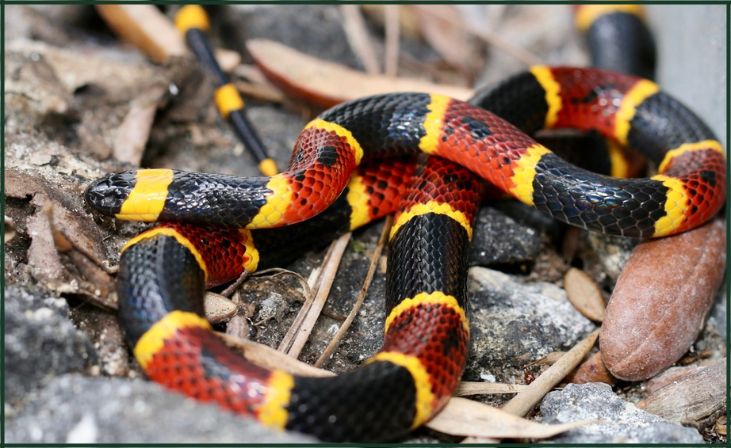
The Eastern Coral Snake (Micrurus fulvius) is a venomous serpent with vibrant red, yellow, and black bands, warning of its potent neurotoxic venom. Found in the southeastern United States, this slender snake is known for its elusive nature and secretive habits. While its bite is rare due to its reclusive behavior, caution is essential, as its venom can lead to respiratory failure and, in severe cases, be lethal. Distinguishing it from non-venomous look-alikes is crucial, as the rhyme “Red on yellow, kill a fellow; red on black, venom lack” helps identify this captivating but potentially dangerous species.
Also, Read – 7 Longest-Living Animals: Your Guide to Timeless Pet Companionship
Copperhead (Agkistrodon contortrix)
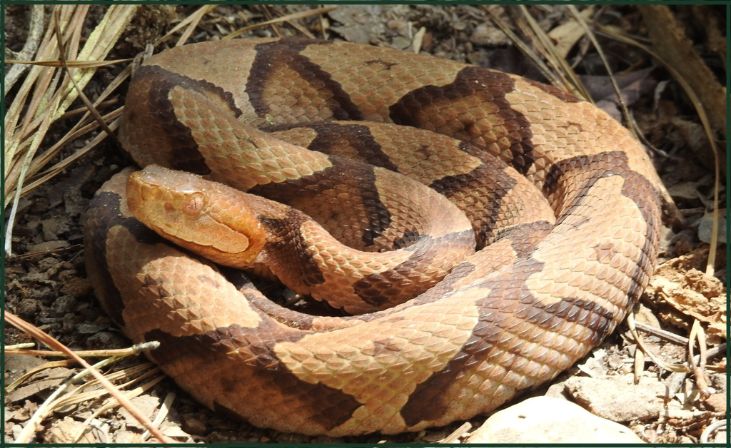
The Copperhead (Agkistrodon contortrix) is a venomous pit viper inhabiting the eastern and central parts of North America. Recognizable by its copper-colored head and distinctive hourglass-shaped bands, it thrives in diverse environments, including forests and grasslands. Though its venom is generally milder compared to other venomous snakes, a Copperhead bite can still cause pain, swelling, and tissue damage. Despite their venomous nature, Copperheads often exhibit a non-aggressive disposition and prefer to avoid human encounters. Awareness of their presence and respectful distance can help mitigate the potential risks associated with these intriguing serpents.
Western Diamondback Rattlesnake (Crotalus atrox)
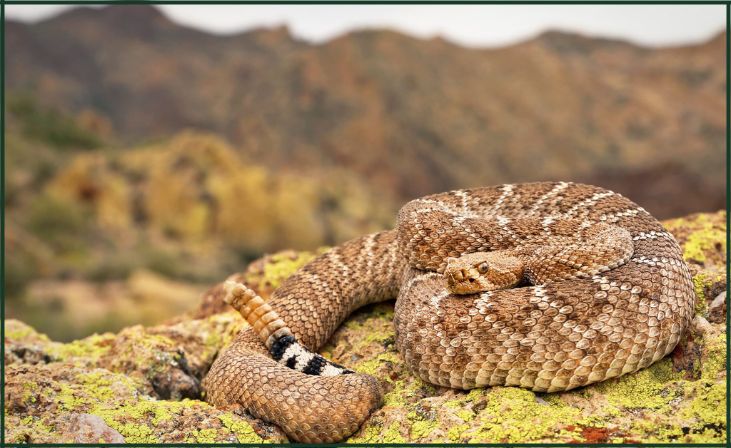
The Western Diamondback Rattlesnake (Crotalus atrox) is a formidable pit viper prevalent in the arid regions of the southwestern United States and northern Mexico. Identified by its diamond-shaped pattern and a rattle on the tail, this snake possesses potent hemotoxic venom, causing tissue damage and potential danger to humans. Well-adapted to varied landscapes, from deserts to grasslands, it plays a crucial role in controlling rodent populations. Though their distinctive rattling serves as a warning, caution and a safe distance are essential when encountering this impressive species, ensuring both their conservation and human safety in their natural habitats.
Timber Rattlesnake (Crotalus horridus)
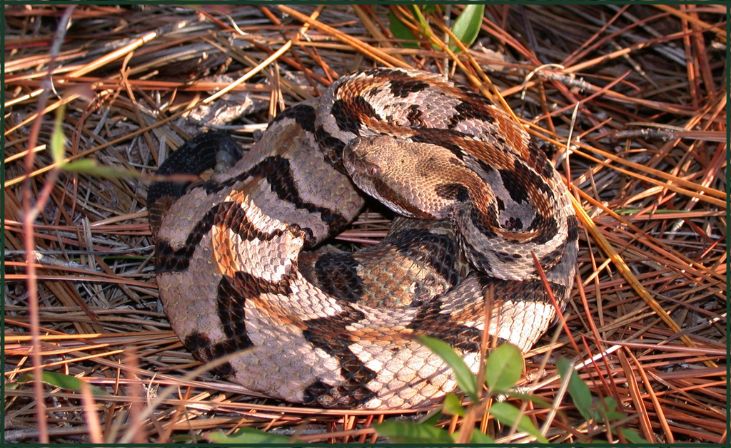
The Timber Rattlesnake (Crotalus horridus) is an iconic venomous serpent found in the Eastern United States. Recognizable by its light-colored body adorned with dark bands and a signature rattling tail, it thrives in diverse habitats, including forests and rocky terrains. While possessing hemotoxic venom that can cause tissue damage, Timber Rattlesnakes are generally reserved and avoid human confrontation. Their role in controlling rodent populations underscores their ecological importance. Encountering one in the wild emphasizes the importance of respectful observation and a cautious distance, acknowledging the significance of these rattlesnakes in maintaining a balanced ecosystem.
Don't just scroll, subscribe!
BuzzTrail's unique web-stories are the cure for boredom you've been waiting for.
Cottonmouth or Water Moccasin (Agkistrodon piscivorus)
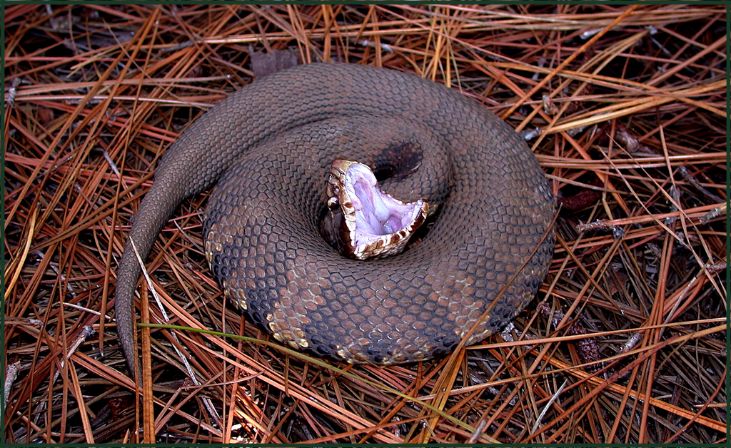
The Cottonmouth, or Water Moccasin (Agkistrodon piscivorus), is a semi-aquatic venomous snake native to the southeastern United States. Recognizable by its dark coloring, distinctive triangular head, and semi-aquatic habits, it often inhabits swamps, rivers, and wetlands. Despite its intimidating appearance, Cottonmouths are generally non-aggressive and prefer to retreat when encountered. Their venom, primarily hemotoxic, can cause tissue damage, but bites to humans are infrequent. Understanding and respecting their habitat is crucial for coexistence, as these snakes play a role in controlling aquatic rodent populations and contribute to the ecological balance of their wetland environments.
Also, Read – The Top 10 Cutest Animals In The World
Southern Pacific Rattlesnake (Crotalus oreganus helleri)
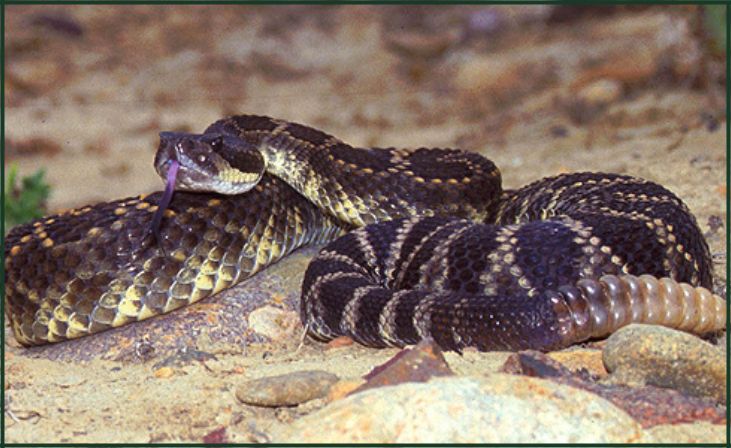
The Southern Pacific Rattlesnake (Crotalus oreganus helleri) is a venomous pit viper residing in the western United States. Recognizable by its varied coloration and the presence of a rattling tail, this species thrives in diverse habitats, including deserts and woodlands. While its hemotoxic venom can cause tissue damage, the Southern Pacific Rattlesnake is typically docile and avoids human interaction when possible. A vital component of its ecosystem, it contributes to rodent control. Encountering this species emphasizes the importance of appreciating their role in the environment and practicing safe, respectful observation from a distance to ensure the coexistence of humans and this intriguing rattlesnake.
Eastern Diamondback Rattlesnake (Crotalus adamanteus)
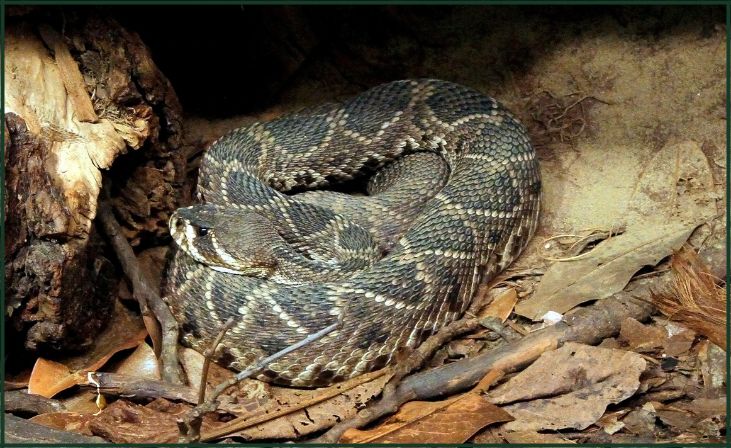
The Eastern Diamondback Rattlesnake (Crotalus adamanteus) holds the title of North America’s largest venomous snake. Distinguished by its diamond pattern and signature rattle, this impressive serpent thrives in the southeastern United States. While its hemotoxic venom poses a potential threat to humans, encounters are rare due to its reclusive nature. As an apex predator, it plays a crucial role in regulating rodent populations, maintaining ecological balance. Conservation efforts are vital for this species, which faces habitat loss and persecution. Awareness and appreciation for the Eastern Diamondback Rattlesnake’s significance in its ecosystem foster a harmonious coexistence between humans and this awe-inspiring reptile.
Mojave Rattlesnake (Crotalus scutulatus)
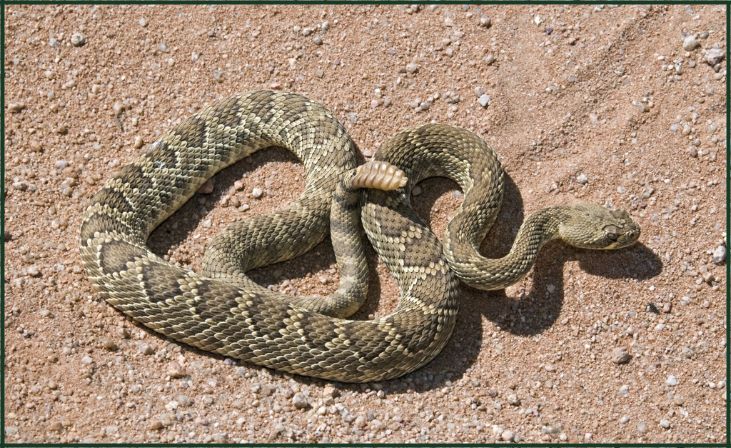
The Mojave Rattlesnake (Crotalus scutulatus) is a venomous pit viper found in the southwestern United States and northern Mexico. Recognizable by its light coloration with a distinct greenish tint, it often possesses a rattle on its tail. This species is known for its potent neurotoxic venom, potentially affecting the nervous system. Despite its venomous nature, Mojave Rattlesnakes are generally elusive and prefer to avoid confrontations. They inhabit a range of environments, from deserts to grasslands. Appreciating the Mojave Rattlesnake’s role in the ecosystem and exercising caution in their presence allows for a respectful coexistence, ensuring the balance of their natural habitats.
Conclusion
In conclusion, fostering a respectful understanding of venomous snakes in your yard is pivotal for promoting a safe environment. By debunking myths and providing insights into identification and prevention, this guide equips you to coexist harmoniously with these creatures. Embracing responsible practices and seeking professional assistance when needed ensures the well-being of both humans and snakes. Remember, a balanced ecosystem allows us to appreciate the diverse wildlife around us while minimizing potential risks. Stay informed, stay cautious, and enjoy the intricate dance of life in your yard.
FAQs
How can I identify a venomous snake in my yard?
How can I identify a venomous snake in my yard?
Look for physical traits like triangular-shaped heads, elliptical pupils, and distinct markings. Familiarize yourself with regional species for accurate identification.
Are all snakes in my yard venomous?
Are all snakes in my yard venomous?
No, the majority are non-venomous. Understanding the characteristics of venomous species helps differentiate them from harmless counterparts.
What should I do if I encounter a venomous snake?
What should I do if I encounter a venomous snake?
Stay calm, maintain a safe distance, and allow the snake to move away. Avoid sudden movements and never attempt to handle it. Call a professional if needed.

